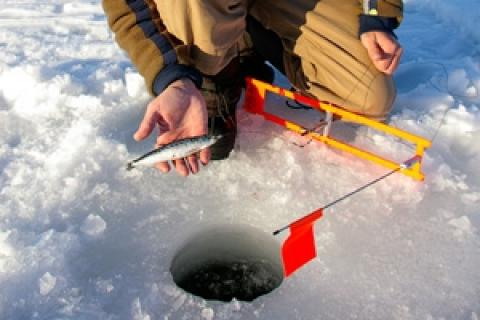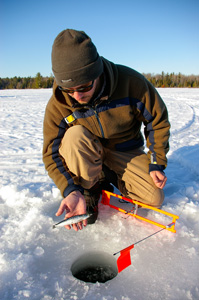
 Snow-covered landscapes and frozen bodies of water have a deliberate way of changing a pike angler's methods and routines. Gone are the oversized spinnerbaits, cranks and spoons — the familiar tools of warm weather fishing — and out come the dead baits, tip ups and quick strike rigs.
Snow-covered landscapes and frozen bodies of water have a deliberate way of changing a pike angler's methods and routines. Gone are the oversized spinnerbaits, cranks and spoons — the familiar tools of warm weather fishing — and out come the dead baits, tip ups and quick strike rigs.
Got Bait?
Dead bait is the preferred tool when chasing winter pike. They represent a large, stationary profile to a hungry fish, triggering instinctive strikes from these freshwater predators. They also provides the perfect scent and taste attributes to attract fish, leaving a magnetic trail washing in the water and arousing their senses. Add to that how easy they are to handle, store and rig, and you’ve got yourself a definite winner.
Smelt, herring, sardine and sucker all make excellent choices (please check local regulations before using), and can be purchased either fresh or frozen from most grocery stores. Suckers can also be caught from local streams or rivers, and put directly in the freezer until needed.
![]() Choose bait between 6 and 10 inches in length, as this seems to be the preferred size for pike, especially during the winter months.
Choose bait between 6 and 10 inches in length, as this seems to be the preferred size for pike, especially during the winter months.
![]() Dead-Bait Tactics for Hardwater Pike
Dead-Bait Tactics for Hardwater Pike
Rigging Dead Fishing Bait
A quick-strike rig provides the perfect presentation when using dead bait. It allows for a single hook to be placed through the lips, while a treble hook is lightly skewered on the upper backside, toward the tail end.
When a pike swims with a bait, turning it around to swallow after a short run, the hooks will usually find a secure place at the front of the mouth on the ensuing hook set. A No. 1 single hook coupled with a No. 4 treble works well in most situations.
Tip Up Choice
In order to present dead bait, a high quality tip up is needed. Regardless of the style you choose, reliance on Dacron or tip up line in 30 to 50-pound test strength is your best bet. I prefer a black colored line as it is easier to see against the snow and ice, especially when handlining fish in.
Smooth drags are also imperative when chasing pike, due to the length of runs and the speed that they can achieve. Make sure that it can run freely, with no hesitation at all.
The trip mechanisms are smooth on these units and can be adjusted for varying degrees of release, making them ideal choices when dealing with weighty dead bait.
Setting Up to Catch Pike
High percentage spots often depend on the body of water, but include shallow and deep weedlines, rivermouths, breaklines and flats. Pike will target these areas in one of two ways — in a patrolling, active feeding mode, or sulking near bottom while waiting for prey to stumble by.
Pike are typically more aggressive when the sun is shining, and mid-morning to late afternoon will usually see them in their hungriest disposition.
Cover a variety of areas with your tip ups when beginning the day from shallow to deep. First and last ice will find fish taking up shop in the shallow stuff, especially adjacent to any green weeds that are still kicking about. Mid-winter will see a shift to deeper water and it may be necessary to punch numerous holes at varying depths in order to connect.
I prefer to suspend dead bait just off bottom, perhaps one to two feet at most. I find the majority of fish (especially when dealing with skinny water) cruise “belly to the bottom,” giving bait presented in this manner the best chance for being seen.
- 5989 views

